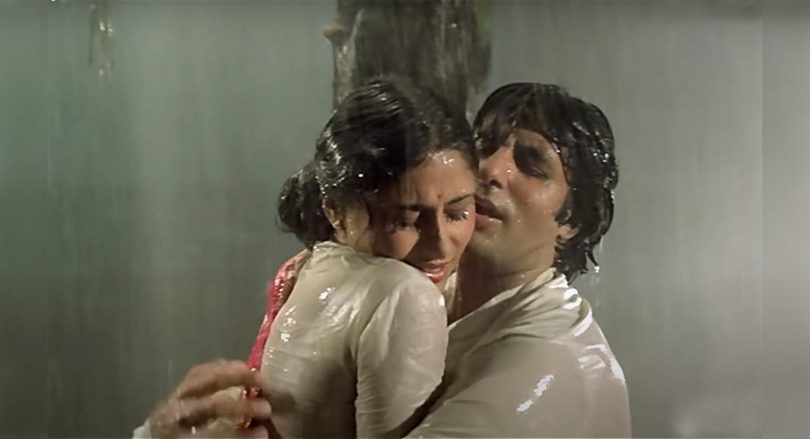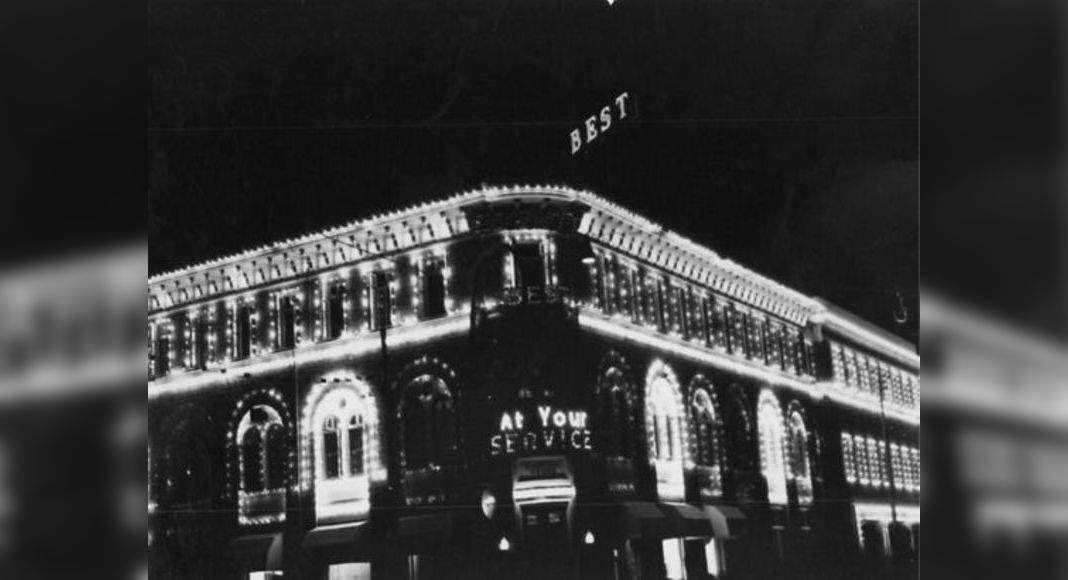My first brush with rain and a song was when I was around seven years old.
My father had taken me to watch Singing in the Rain at the Odeon cinema hall in Delhi.
It was his way of exposing me to music beyond the world of All India Radio and when I saw that famous sequence of Gene Kelly dancing solo with his umbrella in the rain, it blew my mind.
As a kid, jumping on puddles of water was fun but something that we were strongly reprimanded for.
And here I was watching an adult tapping and splashing through puddles with such rhythm and abandon.
I realised that the idea of singing and dancing in the rain wasn’t just cool in my own head but somewhere far away in the world, too.
I was 16 when I first heard ‘O sajana, barkha bahaar aayi’ from the film Parakh.
We didn’t have a TV at home so I had only heard it on radio until I watched the song unfurl as a visual at my neighbour’s house during Chitrahaar.
I stood there transfixed that a black-and-white visual could be so colourful.
Also that the rains could serve as a metaphor for a woman’s emotions.
The sense of reverence, hope and childlike joy in Sadhana with her hands cupped catching rain drops — a classic Bimal Roy shot with hands resembling a womb and water drops symbolic of elixir — remains embedded in my mind as one of the most enchanting rain song moments on screen.
Rain songs are usually known to be vibrant, sensuous and outward but this was an example of how subtle and inward a song about the rains could be.
The hottest woman to appear on screen for me has to be Smita Patil in ‘Aaj rapat jaye’ in the film Namak Halal.
An incredible song that shattered the myth of Smita Patil as the czarina of alternate cinema.
The uninhibited and abashed chemistry between Amitabh Bachchan and Smita Patil — an unlikely couple to frolic in the rain — was simply joyous.
The mad kinky expressions of Kishore Kumar at his flirtatious best in ‘Ek ladki bheegi bhaagi si’ with a rain-soaked Madhubala out alone on a rainy night, remind you of all kinds of mischief that rains inspire.
The rhythm of the song and the idea of having a good time without a care, sums up the beauty, wit and romance of a classic Bollywood and baarish number.
Then there’s everyone’s favourite antakshari song — R for ‘Rimjhim gire saawan’ where you see the beautiful Mumbai landscape when the city was much emptier with two characters walking down drenched streets.
The song that changed my life was ‘Ab ke sawan aise barse’, my first ever album.
I was a Delhiite at the time.
The realisation of what nature and music together could do came to me on a Sunday evening at India Gate.
I was out with friends when it suddenly started to pour.
People stepped out of their cars to dance to ‘Ab ke sawan’ blaring from their car stereos.
The fact that I could capture the euphoria of rain through a piece of music triggered in me a sense of responsibility to create music, not just for entertainment but to make a difference.
I heard ‘Bhaage re mann’ from Chameli when I had just arrived in Mumbai from Delhi.
While watching the song being shot, it was almost like feeling the rain, the shivers and the earthy scent.
A song brimming with hope, innocence and fresh starts.
Life came full circle when the same Kareena Kapoor brought that playful energy to ‘Zoobi Doobi’, a rain song I made for 3 Idiots.
These songs are just a fraction of the kind of magic realism and fantastical moments that Indian cinema has sparked over the years thanks to the rain.
The art of picturising a rain song — in all its gay abandon, innocence and sensuousness — was due to screenplay writers and directors who lived in very different times with very different associations with the rain.
What romance would a young filmmaker living in Mumbai today find in the rains when you are surrounded by potholes and construction sites? When you look out of the window, the changing urban landscape with waterlogging and traffic congestion would naturally disallow the natural thought of rain as a background for two people falling in love under an umbrella.
It’s a sad tragedy of our times that I can’t recall the last time a beautiful rain song got made because psychologically everyone’s like ‘who wants to get out in the rain?’ Rampant urbanisation has robbed the cities of their rainy romance and we see its effect in music and movies too.
Also, the cinematic technique has changed where filmmakers are committing less and less to songs, especially lip-syncs.
Therefore a rain song on its own is a luxury and what we saw in ‘O sajana’ with rain in the foreground is now a distant backdrop 60 years later.
How I wish that a director would use his cinematic artistry to recreate a musical Singing in the Rain moment today — with a leap here and a splash there on wet streets and puddles — and I am certain the rain song will be back.
If it worked then, it will work now.
There’s nothing more unifying than the feeling of breaking away, letting go and being cleansed by the rain.
-As told to Mohua DasIt was pouring in Mumbai when we made Aaj RapatBappi Lahiri, composer Aaj Rapat Jaye To, Namak Halaal When (director) Prakash Mehraji and (lyricist) Anjaanji came to my studio, it was raining a lot in Mumbai.
Mehraji told me, “Bappi, can you make a song about this rain?” The lyrics had been composed by Anjaan ji, who was one of the best writers I have worked with.
I made a mukhda for ‘Aaj rapat jaye to’, and when I played it for Prakashji, he liked it so much that I didn’t even have to try another version.
Though I am credited with bringing disco to India, I also did many numbers inspired by classical ragas.
‘Aaj rapat jaye to’ was a totally Indian song.
I used instruments such as santoor, violin, mandolin and the sitar and the first two helped evoke the mood of the rains.
There are very few rain songs which go on to become evergreen hits, but ‘Aaj rapat jaye to’ went on to become one.
The song’s mazaa (fun) comes also from the singing and dancing.
It was sung by Ashaji (Bhonsle) and Kishore mama (Kumar) who added their own touches such as the arre, arre, arre in the beginning.
Though I composed the song, I do my salaam to both Amitji and Smitaji for that outstanding rain dance.
Nowadays, there are fewer rain songs in Hindi films but I believe they will come back in fashion one day.
On a personal note, I believe the rains have been lucky for me.
I recorded my life’s most memorable song, ‘Chalte chalte’, sung by Kishore Kumar in the 1976 film of the same name during the rains in July.
Now, Namak Halaal is being remade but even if they remix this song, they can’t get Kishore Kumar’s one and only voice.
The magic of ‘Aaj rapat’ can’t be copied.
— As told to Sonam JoshiThe story behind a sizzling rain songViju Shah, Composer Tip Tip Barsa Paani, Mohra Today ‘Tip tip barsa paani’ is considered one of the most sensuous rain songs but it started out as just a peppy, romantic number between Akshay and Raveena.
The mukhda tune had been approved by the director, but Anand Bakshi sahab (the lyricist) felt it was a little too lengthy.
After arguing for an hour, I told him to forget the tune, give me the lyrics, and I would compose it again.
Finally, he told me to play it one more time and suddenly came up with the line ‘tip tip barsa paani’.
The thing was once Bakshi sahab got the first line, the entire song would be over in 10-15 minutes.
When I would play a tune for Bakshi sahab, I would write some dummy lyrics just to give him a feel.
The only line he kept from my dummy lyrics was the last one ‘main kya karun’.
I think he penned the other lines around it: ‘Teri yaad aayi toh jal utha mera bheega badan, ab tu hi bata o sajan main kya karun…’ It was only after he came up with this line that it turned out to be a rain song and (director) Rajiv Rai thought of picturising it that way.
In those times, rain songs were very popular, maybe because of the dance and the sensual element.
Take Mr India’s ‘Kaante nahin kat te’, for instance.
But the song also has to have some beat.
If ‘Tip tip’ only had visuals, why would people still listen to it? Nowadays, there are much fewer rain songs in films.
Similarly, there have been no mujras and qawwalis for many years, maybe because youngsters are not open to that.
Everyone wants to play safe, and everything is either Punjabi or rap.
Today’s directors say they want “halke-phulke words jo logo ko samajh aaye” and insist on some English words.
But I think people will listen to a good track.
Everything that you hear in ‘Tip tip’ — even the tabla — was electronic, created with 12 synthesisers.
The only acoustic element came from the violin.
We had first tried this approach of going all out with electronic in Tridev in 1989, just to give it a new sound.
Today, even I can’t recreate the opening sound of tang nanana tang nanana — that just happened and is the life behind the song.
It is what people remember.
After I recorded it in 1993, many producers would demand this same sound but even I didn’t know what the combination was.
If I hear it and try to analyse it, I may come close, but it wouldn’t be identical.
Honestly, I never expected it would still be playing after 27 years.
It has been remixed so many times, with another one in a forthcoming film.
But it is only the basic arrangement that these remixes change.
The singing is nowhere close to Alka (Yagnik) and Udit’s (Narayan).
— As told to Sonam Joshi



